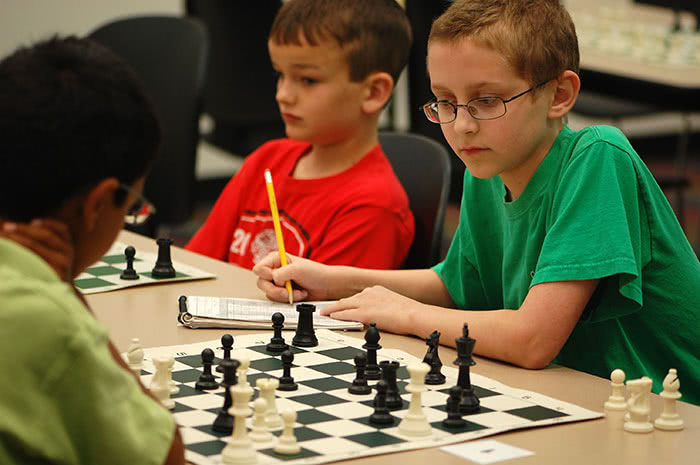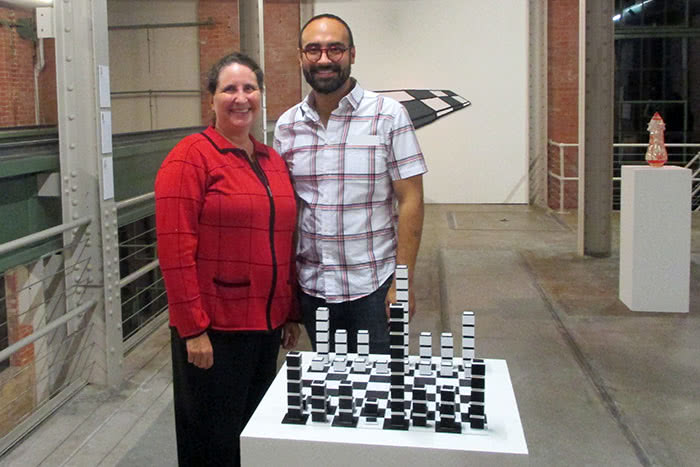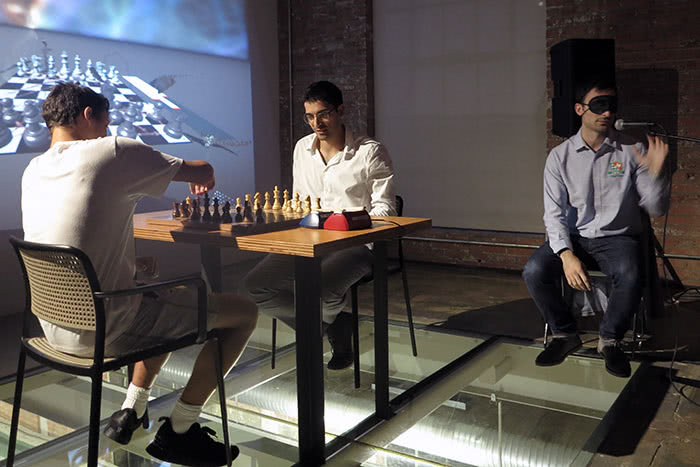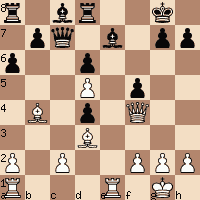Typically, tournament chess players use Staunton chessmen and record their games in algebraic notation. Howard Staunton was perhaps the strongest player in the world from 1843-1851. He promoted a particular design of chessmen. In Staunton’s era, descriptive notation was the standard. Nowadays, algebraic notation is used. Even though Staunton chessmen and algebraic notation are ubiquitous, there are other ways to represent chessmen and their moves.
On May 31, 2008, Michael Borys took a photo of Leo Dobson (son of chess organizer Tricia Dobson) and my son William Root, when both were in a tournament at the Denton Public Library. Leo Dobson and William Root are playing chess with Staunton chessmen on boards that have notation on their borders. Leo is wearing the red shirt, William is holding a pencil and notating the game in his scorebook. Because the photo shows typical tournament chess equipment and notating (writing the chess moves during a game), it became the front cover of my book Read, Write, Checkmate: Enrich Literacy With Chess Activities.

Staunton chessmen somewhat represent the values of chess pieces and pawns. The pawns are the least valuable chessmen, and they are the smallest units on the board. But just from looking at the chessmen, can you tell that a rook is more valuable than a knight? According to the FIDE (World Chess Federation) handbook, the rook should be shorter than the knight. The recommended heights of the pieces and pawns are “King – 9.5 cm, Queen – 8.5 cm, Bishop – 7 cm, Knight – 6 cm, Rook – 5.5 cm and Pawn – 5 cm.” Yet a rook is worth five pawns and a knight is worth three pawns.
Artist Francisco Moreno sometimes forgot he had a valuable, but small, chessman somewhere on the board during his chess games. As I wrote in an article for Chess Life Online, Moreno therefore designed a chess set, the artwork Points, where the values of chessmen are obvious from their structures. For example, the knight is three units high and the rook is five units high. On October 5, I met Francisco Moreno and we posed behind his Points artwork.

That same October 5 evening, the closing of the Good Moves art exhibition at The Power Station, featured a presentation called “Chess Re-Imagined.” The tiny URL for the Chess Re-Imagined Tutorial is bit.ly/ChessReimaginedSlides. The tutorial’s fourth slide introduces “sonification,” which means the “data-dependent generation of sound.” Wikipedia’s page on “sonification” gives the example of a Geiger counter, where the rate of clicking indicates how much radiation is nearby.
After viewing the tutorial for Chess Re-Imagined, audience members and two titled players played regular and tandem chess games on a DGT board hooked up to sound and visual technology. Besides the sounds described in the tutorial, cameras projected images of each game on a screen behind its players. One interesting visual feature was that the Stockfish evaluation showed on the screen, with a stripe alongside the board similar to when chess games are broadcast from tournaments around the world. When the white area next to the screen projection of the board was larger than the black area, that meant that Stockfish was evaluating that position as better for White. A pulsing noise also indicated the evaluations of positions.
The highlight of the evening was a blindfold chess game with sonification. A sighted audience volunteer (playing Black) sat across from International Master Eylon Nakar. Eylon moved the white chessmen for Grandmaster-elect Zura Javakhadze, who was blindfolded. Zura spoke his moves in algebraic notation to Eylon.

Each chessman’s moves were additionally indicated by musical notes and each square also had a unique sound. Theoretically, Zura could play blindfold chess from listening to those notes and sounds. During his blindfold game, the notes played for each chessman and the sounds for each square were broadcast. However, Zura also heard the actual algebraic notation of the square where a piece or pawn had moved. He appeared to mostly listen to that notation, which is very familiar to chess players. At one point, Zura heard “…b6” and asked his assistant, Eylon, “Was that a pawn or a queen that just moved to b6?” Eylon answered “queen” and Zura proceeded with his next move and ultimately won the blindfold chess game.
Apparently, the jazz chord representing the queen had not registered with Zura. That’s not surprising, as Zura had just learned the notes which represented each chessman the day before his performance. However, in his post-game talk, Zura predicted that the sonification technology might enhance chess for all players, perhaps particularly for blind chess players.
Moreno’s Points chessmen may not replace Staunton’s design. Similarly, conveying moves through sonification may not replace algebraic notation. Yet the Good Moves exhibition showed chess in new visual and auditory ways, enhancing our appreciation of chess as art and as technology. Thanks to The Power Station for providing a memorable chess exhibition.
As readers know from my previous SparkChess article, Eylon Nakar is a formidable chess player capable of defeating rising chess stars such as WGM Carissa Yip. Though, on October 5, Eylon was merely the assistant of a blindfolded Zura. The spotlight was definitely on UT Dallas chess team member Zura and his Chess Re-Imagined colleagues (award-winning composer Scot Gresham-Lancaster, computer scientist William Thibault, and audio cognition expert Sharath Chandra) on October 5.
Two days earlier, however, Eylon was the star of that Friday’s chess club meeting at The University of Texas at Dallas. Chess team members such as Eylon take turns, each Friday, presenting to those who attend chess club. The chess club is open to UT Dallas students, faculty, staff, and members of the public. At the October 3 meeting, Eylon presented one of his best games. Can you find the tactic that Eylon played, as White against IM Nathan Birnboim, on move 17?

The right answer is 17. Ba5, deflecting the black queen from defending the black bishop on e7. This ultimately allowed White to penetrate on the seventh rank with Rxe7, leading to an overwhelming attack and victory for White.
